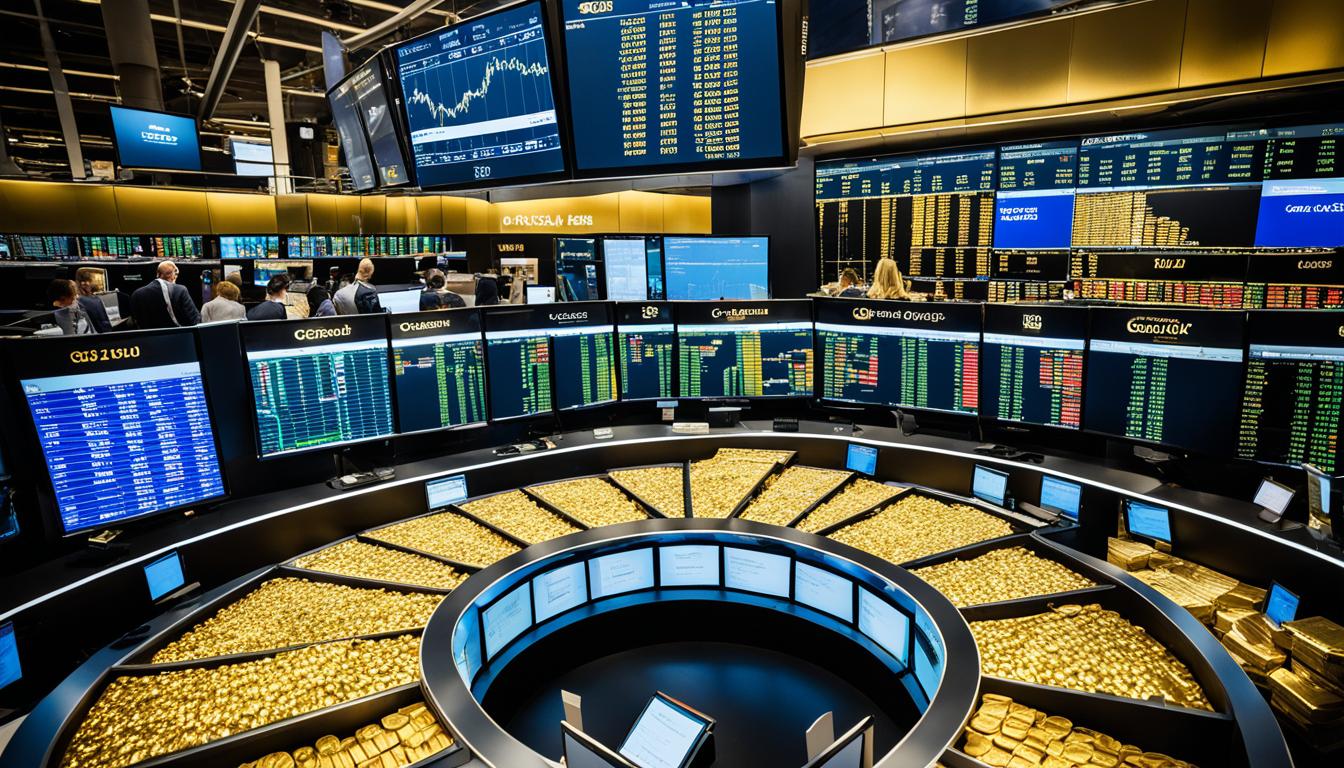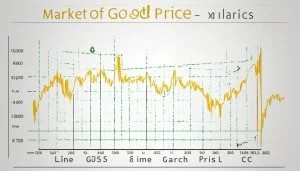For astute investors and financial connoisseurs, understanding the gold price today is critical in navigating the bullion market with precision. As we witness fluctuations in the current gold rate, it is paramount to have a resource that presents the spot gold price per ounce with real-time accuracy and reliability.
The market price of gold stands not merely as a figure but as a beacon, signaling the currents of global finance. Comprehending these indicators is indispensable for those considering an investment in gold. Whether the aim is to diversify portfolios or hedge against economic uncertainties, the relevance of instantaneous gold pricing cannot be overstated.
Understanding Gold Spot Prices And Market Trends
At the heart of gold trading are the continuously fluctuating spot prices, which play a critical role for investors and buyers in the gold market. Keeping abreast of gold market trends is not just beneficial; it is necessary for making educated decisions in a landscape defined by its dynamism.
Live Gold Price Data And Its Significance
For those actively engaged in gold trading, live gold data is indispensable. The immediacy of real-time price updates means that every second can count, offering the latest snapshots of market sentiment and facilitating prompt trading decisions. BullionVault’s graphs and ticker information give traders critical information that’s up-to-date, providing insight into short-term fluctuations and potential trading opportunities in the gold market.
Historical Gold Price Trends Over The Last 20 Years
In addition to current data, learning from the past is a powerful tool. With up to two decades of historical gold prices at their fingertips, investors and analysts can discern clear patterns and trends that influence today’s trading strategies. This long-term view sheds light on how global events have historically affected the market and can offer a guide to future market behavior.
Gold Price Variations Across Different Currencies
The international nature of gold trading means that currency gold price variations are a crucial factor to consider. The value of global currencies can directly impact gold prices, and analyzing these variations is key to understanding gold’s purchasing power in different markets. As London bullion banks set the standard for these prices, international traders can gain perspective through currency-specific charts, aiding in strategy development.
- The BullionVault chart is a trusted source for accurate live gold data.
- Historical gold prices paint a more comprehensive picture of the gold market trends.
- Understanding currency gold price variations prepares traders for more nuanced investments.
The dynamics of the gold market are complex, but with keen attention to live data, historical trends, and currency impacts, one can navigate the terrain of gold investment with greater confidence and acumen.
Factors Impacting Gold Prices Today
Understanding the complexities of gold price factors involves an interplay of diverse elements, ranging from macroeconomic shifts to supply and demand dynamics. Assessing these components provides a window into the fluctuating nature of gold price trends.
Among the key economic influences on gold, inflation and interest rates emerge as pivotal. Inflation often enhances gold’s allure as a hedge, whereas interest rate changes influence investor’s opportunity costs associated with gold holdings:
- Inflation trends drive demand for gold as a value store.
- Variations in interest rates affect the attractiveness of holding gold, as they compete with yield-generating assets.
Moreover, geopolitical gold price impact cannot be overlooked as international tensions and economic sanctions can prompt a surge in investment towards gold, considered a safe-haven asset:
- Geopolitical instability increases gold’s appeal as a risk-averse investment.
The strategies of central banks in managing gold reserves also significantly influence market supply and prices, reflecting the importance of high-level economic influences on gold:
- Central bank policies can lead to substantial inflows or outflows from gold markets, affecting availability and price.
Sentiment among investors, swayed by current events and market speculations, adds to the gold price volatility, displaying the real-time response of gold markets to global happenings:
- Current events triggering short-term market sentiment shifts.
- Speculative trading based on technical analysis and market forecasts.
Lastly, the traditional supply and demand dynamics of gold production and consumption continue to be a bedrock factor in determining its price:
- Mining output and technological advancements in gold extraction.
- Demand from industry, jewelry, and investment.
In conclusion, these factors collectively contribute to the layered and sophisticated narrative behind today’s gold price movements, proving the metal’s status as a complex financial instrument sensitive to a spectrum of global forces.
How Gold Trading Works On Global Exchanges
The world of gold trading extends far beyond the physical buying and selling of the precious metal; it’s an intricate network of transactions on global exchanges, utilizing a variety of financial instruments. These exchanges play a vital role in the determination of gold prices and provide platforms where traders and investors can engage in the procurement of gold through multiple avenues.

The Role Of LBMA In Gold Price Determination
At the heart of the gold trading ecosystem is the London Bullion Market Association (LBMA). Recognized globally for its authority in the market, the LBMA establishes the standards for the quality of gold bars and oversees the mechanism for setting the gold spot price. This is determined through the process of electronic auctions, which are heavily relied upon to maintain transparency and stability in the market. These standards are crucial for parties engaged in gold trading platforms, safeguarding integrity across all transactions.
Gold Futures And Options: An Introduction
Beyond the immediate trading of spot gold, the market also offers gold futures and options. These derivative products are held on exchanges such as COMEX, and are essential for investors and traders looking to speculate on the future prices of gold without the immediate need for the physical commodity. They provide a hedge against price volatility and allow for a greater range of strategic trading options:
- Gold Futures contracts enable purchasing or selling at a predetermined price at a future date, reflecting market expectations.
- Gold Options grant the right, but not the obligation, to buy or sell gold at a set price within a specific time frame, offering flexibility.
Other Exchanges Influencing Gold Price Discovery
Apart from the LBMA and futures-forward COMEX, there are other notable gold exchanges that contribute significantly to price discovery, including the Shanghai Gold Exchange and the Tokyo Commodity Exchange. These platforms cater to their regional markets while also impacting the global gold price through their collective trading volumes and the local market sentiment they reflect. As financial hubs for gold trading in their respective regions, they capture the economic trends and investment behaviors that shape the precious metal’s global trajectory.
Gold Prices Per Ounce: Real-Time Data Insights
The landscape of gold investment insights is ever-changing, and keeping abreast with real-time gold prices is critical for investors. With the advent of real-time market data, the ability to make quick and informed decisions is at the fingertips of traders and analysts alike. Through seamless access to up-to-the-minute gold market data, investors can now experience unparalleled transparency when it comes to understanding and predicting market movements.
Real-time data on gold prices is not just a numerical update but a comprehensive snapshot of the gold market’s vitality. This data captures the nuances of supply and demand fluctuations, often influenced by global economic events, central bank policies, and changing investor sentiments. As currencies pivot and commodities react, gold remains a notable constant, often measured as a signal of market health and a vehicle for wealth preservation.
- Instantaneous updates of gold prices per ounce for tactical trading maneuvers
- Analytical tools for longer-term portfolio assessment and management
- Clear representation of global gold supply and demand ebbs and flows
- Adaptation to crucial FX market oscillations impacting gold valuation
The connection between gold investment insights and their real-time availability is significant for grasping not only day-to-day value changes but also the broader economic implications. Whether it’s for an immediate trading opportunity or for a strategic adjustment in investment allocations, access to real-time gold data ensures that decisions are based on the most current market information available, defining a new era of informed financial strategy.
The Correlation Between Economic Indicators And Gold Value
As a timeless asset, gold has continually demonstrated a unique relationship with key economic indicators. Experts and investors closely observe these patterns to guide their investment strategies and protect their assets against market fluctuations.
Gold As An Inflation Hedge
The concept of gold inflation hedge resonates with investors worldwide due to gold’s historical performance during periods of high inflation. Remarkably, the yellow metal’s value tends to rise when the purchasing power of fiat currencies decreases, solidifying its status as a steadfast holder of wealth.
Interest Rates And Their Influence On Gold Prices
Understanding gold interest rates dynamics is crucial for any investor. Generally, there is an inverse relationship; when interest rates fall, the opportunity cost of holding non-interest-yielding assets like gold diminishes, thus, increasing its allure.
Gold’s Response To Geopolitical Instability
Gold’s reputation as a safe haven sharpens in response to global uncertainties. Whether due to political tensions or financial crises, spikes in demand for gold are often observed during times of geopolitical effects on gold, reasserting its pivotal role in stabilizing investment portfolios.
Comparing Physical Gold And Gold Derivatives
Investors considering a foray into the precious metals market commonly evaluate the merit of physical gold investment against the allure of gold derivatives, including gold Exchange-Traded Funds (ETFs) and futures. The decision-making process pivots on a comprehensive understanding of the distinctive advantages and disadvantages inherent to each investment vehicle.
Physical gold, cherished for its tangible nature, enables investors to own the metal outright. This carries an inherent value independent of financial systems and geopolitical influences, free from counter-party risks that are often associated with derivative instruments. Moreover, the cost of owning physical gold is relatively straightforward, generally involving a definite premium above the market’s spot price to account for manufacturing and distribution.
- Physical Gold: Direct asset ownership, a premium over spot price, no counter-party risk.
- Gold Derivatives: Contract-based, complex pricing, and potential liquidity.

On the other hand, gold derivatives such as gold ETFs and gold futures present a viable path to investment without the hefty upfront costs and logistical considerations of physical storage. Gold ETFs mirror the performance of physical gold, offering a cost-effective and flexible approach to gold investment. Meanwhile, gold futures allow for speculation on the future price of gold, opening an avenue for potential gains through strategic trading and hedging. Despite the attractive entry points and liquidity of gold derivatives, one must navigate the intricacies of contract terms, management fees, and the potential for counter-party risk.
In summary, when weighing physical gold investment against the ephemeral nature of gold derivatives, the investor’s thesis should align with their risk tolerance, investment strategy, and desired level of involvement with physical assets. Both vehicles hold the promise to diversify an investment portfolio and hedge against market volatility, each with a unique set of benefits and risks.
Historic Milestones In Gold’s Price Journey
Tracing the trajectory of gold price records, we observe a tapestry of significant milestones that have defined its stature as a premier asset in the investment world. These markers of gold price appreciation are not just figures but reflections of the world’s economic heartbeat. From geopolitical shifts to monetary policy adjustments, each peak and trough tells a unique story of value and stability.
Record-Breaking Prices: Analysis Of Peaks
The dazzling heights reached by gold with a record-breaking price in December 2023 placed the precious metal in the spotlight, drawing attention to its role as a harbinger of economic sentiment. Factors ranging from market liquidity to inflation expectations were dissected to understand gold’s unyielding allure during times of financial duress.
Gold Price Appreciation Over Decades
Year after year, gold has proven to be a cornerstone for wealth accumulation, with an average annual appreciation rate that has cemented its position in diverse investment portfolios. This consistent upswing in value over the decades underscores gold’s unshakeable reputation as a long-term store of value.
Global Gold Reserves And Production Trends
Mapping out the landscape of global gold reserves, it is apparent that the United States and Germany have set the precedent, holding the largest stockpiles. These reserves not only boast stability in the gold markets but also serve as a formidable axis of economic leverage.
Gold Investment Strategies For Beginners And Experts
Whether you’re new to the world of gold investments or an experienced market player, crafting a gold investment strategy that withstands the test of time is essential. Diving into the intricacies of market timing, understanding commodity ratios, and maintaining investment diversification are central to managing and growing your wealth within the precious metals space.
Timing The Market: Using Historical Data
Expert investors know that market timing can be a powerful aspect of a gold investment strategy. Historical data serves as a navigational chart for when to enter or exit the market. This approach doesn’t require predicting future prices but involves recognizing patterns that signal potential shifts, which can be discerned from gold price charts and past market performance.
Understanding The Gold/Silver Ratio
The gold/silver ratio has been a traditional measure to gauge the right time to purchase or sell precious metals. By tracking the value of gold relative to silver, investors can identify overvalued or undervalued conditions in the market. A high ratio may indicate that gold is overpriced or silver is undervalued, and vice versa, leading to strategic investment decisions between the two metals.
Diversification And Hedging With Gold
Investment diversification is a cornerstone of sound investing, and gold plays a pivotal role in this. Diversifying your portfolio with gold not only spreads risk but also provides a hedge against inflation and currency devaluation. In volatile economic times, gold can act as a financial safe haven, retaining value as other assets fluctuate.
- Review historical market trends and seasonal cycles in gold prices.
- Monitor the gold/silver ratio alongside broader economic indicators.
- Allocate a proportion of your portfolio to gold, balancing it with other investments.
By integrating these components into your approach, from market timing to the gold/silver ratio, you develop a solid and dynamic gold investment strategy, aligned with both your risk tolerance and long-term financial goals.
Conclusion
In summary, the journey through the intricacies of the gold market reveals a canvas painted with various economic indicators and market dynamics. The current gold investment outlook remains robust as investors continue to view gold as a beacon of stability amidst financial turbulence. The gold market summary, encapsulating real-time data, historical patterns, and a pulse on global exchanges, escorts investors through the labyrinth of decision-making in the realm of gold investments.
Considering both tangible bullion and gold derivatives enriches an investor’s strategic arsenal, allowing for flexibility and sophistication in managing gold-related financial instruments. While spot prices paint the daily picture, it’s the comprehension of longer-term trends and economic drivers that capacitate investors to foresee and exploit potential opportunities in the gold market.
Ultimately, discernment paired with informed investment strategies ensures that gold retains its luster as a perennial component in diversified portfolios. It’s this enduring value proposition that makes gold an indispensable asset for those seeking to fortify their holdings against the ebbs and flows of economic uncertainty.
FAQ
What Is The Current Gold Price Per Ounce Today?
The current gold prices per ounce are updated in real-time and do not require refreshing your browser. For the most accurate and up-to-date gold rates, investors should refer to live gold price tracking services.
Why Is Live Gold Price Data Significant For Investors?
Live gold price data is crucial for investors as it allows them to make informed decisions based on the fastest updates available on the market. This is especially important for short-term trading and for keeping pace with the volatile nature of the gold market.
How Do Historical Gold Price Trends Over The Last 20 Years Help Investors?
Historical data provides a view of long-term trends in gold prices, which is valuable for understanding overall market movements, making strategic investment decisions, and assessing gold’s performance as a long-term asset.
In What Currencies Can Gold Price Variations Be Analyzed?
Gold price variations can be analyzed in several major currencies, such as US Dollars, Euros, and British Pounds, which highlights the impact of exchange rate fluctuations on the price of gold in different regions.
What Factors Are Impacting Gold Prices Today?
Gold prices are influenced by a range of factors, including macroeconomic indicators like inflation and interest rates, geopolitical instability, shifts in supply and demand dynamics, central bank policies, and currency valuations, particularly the US Dollar.
How Does The London Bullion Market Association (LBMA) Play A Role In Gold Price Determination?
The LBMA sets the standards for the gold bullion market and conducts auctions to determine the daily spot price, which is recognized globally and reflects the consensus price determined by London’s largest bullion banks.
What Are Gold Futures And Options, And How Do They Affect The Spot Price Of Gold?
Gold futures and options are contracts traded on exchanges like COMEX that offer indicators of future gold prices. Their trading activities can directly influence spot prices, reflecting market expectations and speculative sentiment.
Can Gold Be Considered An Inflation Hedge?
Yes, gold is traditionally viewed as an inflation hedge because it retains its value over time, particularly when fiat currencies are losing purchasing power.
How Do Interest Rates Influence Gold Prices?
Interest rates have an inverse relationship with gold prices since lower interest rates decrease the opportunity cost of holding non-yielding bullion, thereby making gold a more attractive investment.
What Is The Difference Between Physical Gold And Gold Derivatives Like ETFs And Futures?
Physical gold involves owning the actual metal with no counter-party risk, whereas gold derivatives such as ETFs and futures are financial instruments based on the price of gold. Derivatives offer more accessible investment into the gold market without the need for physical storage, but come with different cost structures and inherent risks.
What Are Some Historic Milestones In Gold’s Price Journey?
Gold’s price journey includes historic highs, such as its peak in December 2023. These milestones are influenced by various factors including global economic situations, monetary policy, and market speculation.
How Can Investors Time The Market Using Historical Gold Data?
By studying historical data and pattern recognition, investors can attempt to time the market by identifying potential trends and capitalizing on recurring cycles of gold price movements for buying and selling.
What Is The Gold/Silver Ratio, And Why Is It Important?
The gold/silver ratio measures the amount of silver it takes to purchase one ounce of gold. Investors use the ratio to determine relative value between the two metals and to decide on asset allocation in a diversified investment portfolio.
Why Is Diversification And Hedging Important In Gold Investment?
Diversification and hedging with gold can help manage risk in an investment portfolio. Gold has a historical reputation as a safe-haven asset, so it can provide stability and protection against market volatility and economic downturns.


